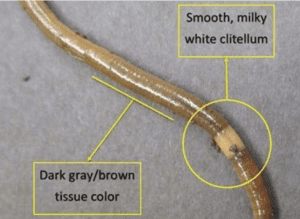Jumping worms. Crazy worms. Snake worms. These nicknames apply to invasive earthworms of the genus Amynthas found in the United States. These Asian worms have been in the U.S. for years but have recently been in the spotlight due to the damage they can cause. Globalization, commerce, and development have contributed to their spread.
There are extremely few native earthworm species in the northeastern United States. Worm populations were eliminated during the last Ice Age. Our local ecosystems developed since the last Ice Age without worm activity. In addition to Asian earthworms, night crawlers and other non-native earthworms have been introduced to northeastern North America.
Jumping worms take their earthmoving abilities to the extreme. In unmanaged, natural environments, their activities homogenize the leaf litter and other materials on the forest floor. Many plant species require a natural layer of leaf litter for successful germination and to obtain the nutrients in forest floor materials. In managed areas, such as lawns and gardens, these earthworms can destroy areas due to their voracious appetites, leaving only their castings and nullifying soil benefits.
Adult jumping worms die with the New England frost. However, they reproduce asexually, with no need for a mate, very often. Their cocoons, holding their eggs, survive our winters, hatch, and begin their destruction anew.
If you suspect you find jumping worms, the identification can be confirmed on adult worms by the clitellum, or reproductive organ, which is white and smooth and extends fully around the worm’s body, just under the head area.
Unfortunately, there is not much to control these worms. Adults can be killed but the populations are so vast that this will not accomplish much. You can purposefully NOT buy Amynthas worms for any activity (composting, vermicomposting, bait, etc.). For composting, specifically ask for Eiseniafoetida, the red wiggler worm. Do NOT discard live worms into the wild. Kill the worms, if possible, and put in the trash. Be careful when purchasing, moving, or sharing plantings, as the adult Amynthas worms and their cocoons might be in the soil.
This is a difficult premise as we all learned that worms are good and helpful for our soils.
By Gail K. Reynolds, M.F.S
